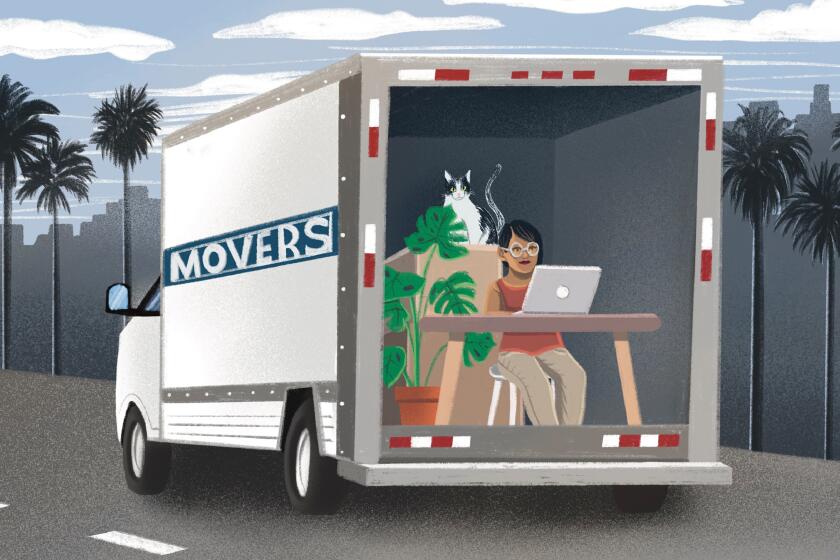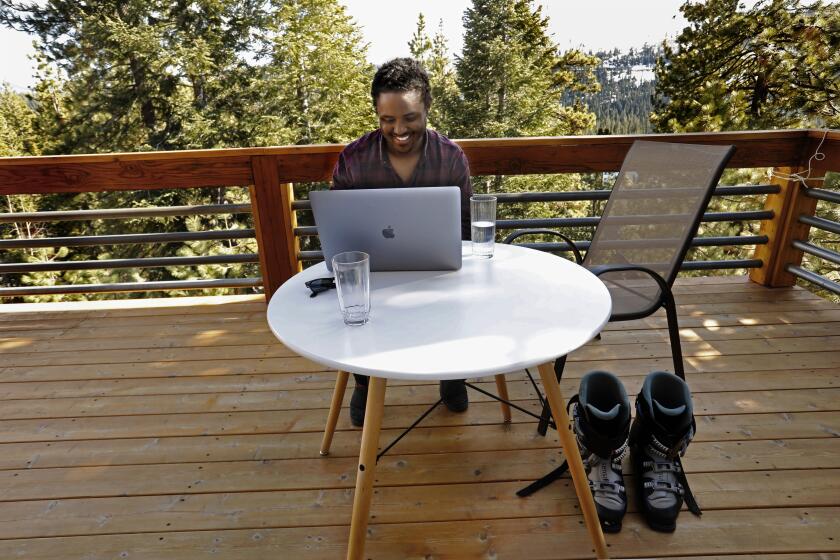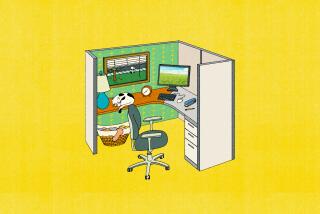Welcome to the summer of quitting. Why many of us are saying goodbye to our jobs

- Share via
In late May, Sarah Lynch pulled the rip cord.
The 31-year-old brand designer had been working at Coursera, the online education company, for five years. During the pandemic, a booming business in virtual learning meant Lynch was busier than ever — and sinking into burnout.
“I love my company, and I love my work, but I couldn’t keep pushing on through,” Lynch said. “I didn’t have really any energy, I didn’t really enjoy what I was doing anymore, I couldn’t really focus.”
Then Coursera went public. Like many workers on the upper levels of the income scale, whose savings have been buoyed by a bull market, Lynch found herself sitting on a financial cushion for the first time in her life thanks to her stock options.
“I recognize it’s extremely privileged to have this cushion now, but I can take the time off that I’ve really been wanting to,” Lynch said. “I don’t have another job lined up after this, and that’s like — I come from a working-class background, you don’t just quit a job and not have another job.” But she’s looking forward to spending time working on her design portfolio, slowing down, reading some books and taking a pottery class.
“I haven’t had a break in 10 years,” Lynch said, since she graduated in the recession, worked her way through a master‘s degree and landed a good job. Now she’s rethinking her future: “Do I really want to burn myself out over and over again?”
Lynch is part of summer 2021’s hottest professional trend: quitting your job.
Leaving your job isn’t always an easy decision. Here’s what you should know before you decide to quit your current role.
More than 3.9 million people quit in April, according to the Bureau of Labor Statistics, marking the highest quit rate — the ratio of people quitting their jobs to total employment — since the agency began collecting that information in 2000. The number of job postings also hit a record high, with 695,000 more open positions than unemployed workers.
Workers in industries that typically have a high level of turnover, such as retail, warehousing and food service, quit in large numbers. Professional and business services — a catch-all category that includes many of the country’s office jobs — saw the second-highest surge in quits, with 94,000 more workers leaving their jobs in April than in March.
Production remains hampered by restrictions necessary for keeping the COVID-19 pandemic at bay, but filmmakers and studios are optimistic that Hollywood is finally reopening.
Untangling trends and meaning from national numbers can be difficult, and quitting is not an option to be taken lightly for most workers. In hospitality or Hollywood, where most workers have been out of a job for much of the last year, going back to work at all is still a priority.
But human resources experts say that the white-collar workforce has multiple reasons to be eyeing the exits this summer.
Anthony Klotz, a professor of management at Texas A&M’s Mays Business School, has researched the psychology of quitting for much of his career. He said the numbers point to pent-up demand for a change. Nearly 6 million fewer people quit their jobs in 2020 than in 2019, according to BLS statistics, which Klotz ascribes to workers “sheltering in place” as the pandemic rocked the global economy.
After a year of unprecedented stress, workers are also burned out and reexamining how to live their lives. “People have had epiphanies over the past year,” Klotz said. “We all want to pursue life, liberty and happiness, and many of us have realized our job isn’t the best way to get there.”
At the same time, the booming stock market, reduced expenses under lockdown, extended unemployment benefits and financial stimulus have meant that segments of the workforce have healthy savings accounts — or at least less debt to worry about if they take the plunge.
Working from home will become the norm for many employees even after the pandemic ends. But prepare for a pay cut.
Brett Wells, director of people analytics at Perceptyx, a company that works with a number of Fortune 500 companies to survey employee opinion and sentiment, said his firm keeps close tabs on whether employees are thinking of quitting. “When an employee tells you they’re going to leave, they do,” Wells said. “We’ve seen that spike, for a variety of reasons.”
The top reason for wanting to leave, Wells said, is the desire for flexibility, both in hours and the ability to work from home. “That’s at the forefront as offices start to go back,” Wells said. “If organizations don’t meet those demands, we’re going to see people vote with their feet.”
Wells said that higher echelons of management tend to be stuck on the idea of “office-ism”: that in-person work is intangibly superior. That attitude shows up in corporate leadership regardless of the age or generational cohort of leaders, according to Perceptyx research.
After the executive ranks, Gen Z workers — those in the first few years of their careers — are the most likely to want to return to the office, Wells said. Despite being full digital natives, these younger workers say in surveys that they’re the most afraid of missing out on professional development by working remotely.
One group in particular has already dropped out of the workforce in record numbers: working mothers.
“We’ve seen them mass exit in much larger waves,” in both front-line and senior leadership positions, Wells said, as the demands of juggling parenting, teaching and working from home ratchet higher. Regardless of parental status, Perceptyx has also found that men are more enthusiastic about returning to the office, with women expressing a desire to go back in one fewer day per week on average than their male peers.
But this summer may just represent a continuation of trends that have been building for years, said Tami Simon, who leads the global consulting business at the benefits and HR consulting firm Segal.
“I think we sometimes have the tendency to oversimplify these issues,” Simon said. Demographic shifts in the American workforce mean that just as baby boomers are starting to leave the workforce in larger numbers, millennials are hitting their prime working years, when they have the most job mobility of their careers.
Here are some insights into how employees and bosses can agree on remote work arrangements that work for everyone involved.
“The good news is organizations are great at innovating, but they need to be as innovative in terms of how they manage and retain employees as they are in the core of their business,” said Texas A&M professor Klotz.
Based on conversations he’s had with people this year, he believes we may see a shift toward shorter workweeks as employers try to accommodate shifting demands. “A number of people don’t want to work 40 hours a week, they want to do 20 or 30, with the understanding that there’s less pay,” Klotz said. “You might think, ‘Oh, these are millennials who don’t want to work as much,’ but a lot of people I talk to are people near retirement, saying they could work another 10 years at 30 hours, but not 40.”
Klotz has also seen some companies shift to offering annual monthlong sabbaticals to avoid burnout and sees offering more flexible work-from-home arrangements as part of a retention strategy.
“From a research standpoint, one of our fundamental needs as human beings is the need for autonomy,” Klotz said. Employers demanding a return to in-person work are “asking us to give up this fundamental need we’ve had satisfied during the pandemic” by working at home.
But shifts in benefits and working structures won’t be enough to keep people who want a major change.
“I’ve been going through it, honestly,” said Krystine Altamirano, a 28-year-old Miamian who works in accounting at a private equity firm that she plans to leave in August — her contract required her to give 90 days of notice.
The decision to quit wasn’t easy for Altamirano, who thought she was on a clear career path in finance before the pandemic gave her time to rethink everything. “I’ve been kind of beating myself up, like everyone else does this, everyone else has stressful jobs, and they just deal with it and eventually retire,” Altamirano said.
But in the spring, she realized she couldn’t go on. “Life shouldn’t be so stressful all the time,” she said. “Capitalism has just gotten more and more detrimental to people’s mental health.”
She wants to change careers entirely, maybe shift to education, and plans to figure out where to go next after taking some time off and living on her savings.
And knowing that she’s part of a quit wave this summer comes as a comfort. “I think it’s cool that it’s such a common thing now,” Altamirano said. “It makes me feel less alone.”
More to Read
Inside the business of entertainment
The Wide Shot brings you news, analysis and insights on everything from streaming wars to production — and what it all means for the future.
You may occasionally receive promotional content from the Los Angeles Times.














